Hearst Castle is a National Historic Landmark located on California's Central Coast. Built between 1919 and 1947 by William Randolph Hearst, it features 127 acres of gardens, terraces, pools, and walkways, as well as a main mansion with Spanish and Italian antiques. A private movie theater, zoo, tennis courts, and swimming pools were also part of the estate's opulent amenities.


1. Overall Rating (0–10) — 6.0
This photograph captures a candid moment from a children’s event, emphasizing participation and movement through a tight, low-angle perspective. The focus on the wristband and the child’s hand creates a sense of immediacy and personal connection, while the visible event program adds narrative context. However, the composition feels slightly cluttered and lacks visual cohesion, with overlapping elements that distract from the central subject. The image succeeds as a documentary snapshot but falls short of artistic refinement.
2. Composition (0–10) — 5.5
The diagonal lines of the pavement and the positioning of the arms create a dynamic but uneven balance. The framing is tight, emphasizing the wristband and hand, yet the inclusion of multiple subjects and objects in the lower right creates visual confusion.
3. Lighting (0–10) — 6.0
Natural, ambient light provides even illumination across the scene, though it lacks directionality or dramatic contrast. The lighting is functional but does little to enhance mood or depth.
4. Color & Tone (0–10) — 6.5
The bright blue of the shirt and the green sleeve provide a cheerful contrast against the muted gray pavement. The color palette is lively but not harmoniously balanced, with some areas appearing oversaturated while others remain flat.
5. Creativity (0–10) — 6.0
The low-angle perspective and focus on the wristband offer a unique point of view, suggesting a story of participation and belonging. However, the image leans more toward documentation than expressive storytelling.
6. Technical Quality (0–10) — 7.0
The image is sharp and clear, with good focus on the wristband and hand. The resolution and detail are strong, though the composition and framing limit the overall impact.
7. Emotional Impact (0–10) — 5.5
The photograph evokes a sense of youthful energy and involvement, but the lack of a clear focal point and emotional connection prevents it from resonating deeply with the viewer.
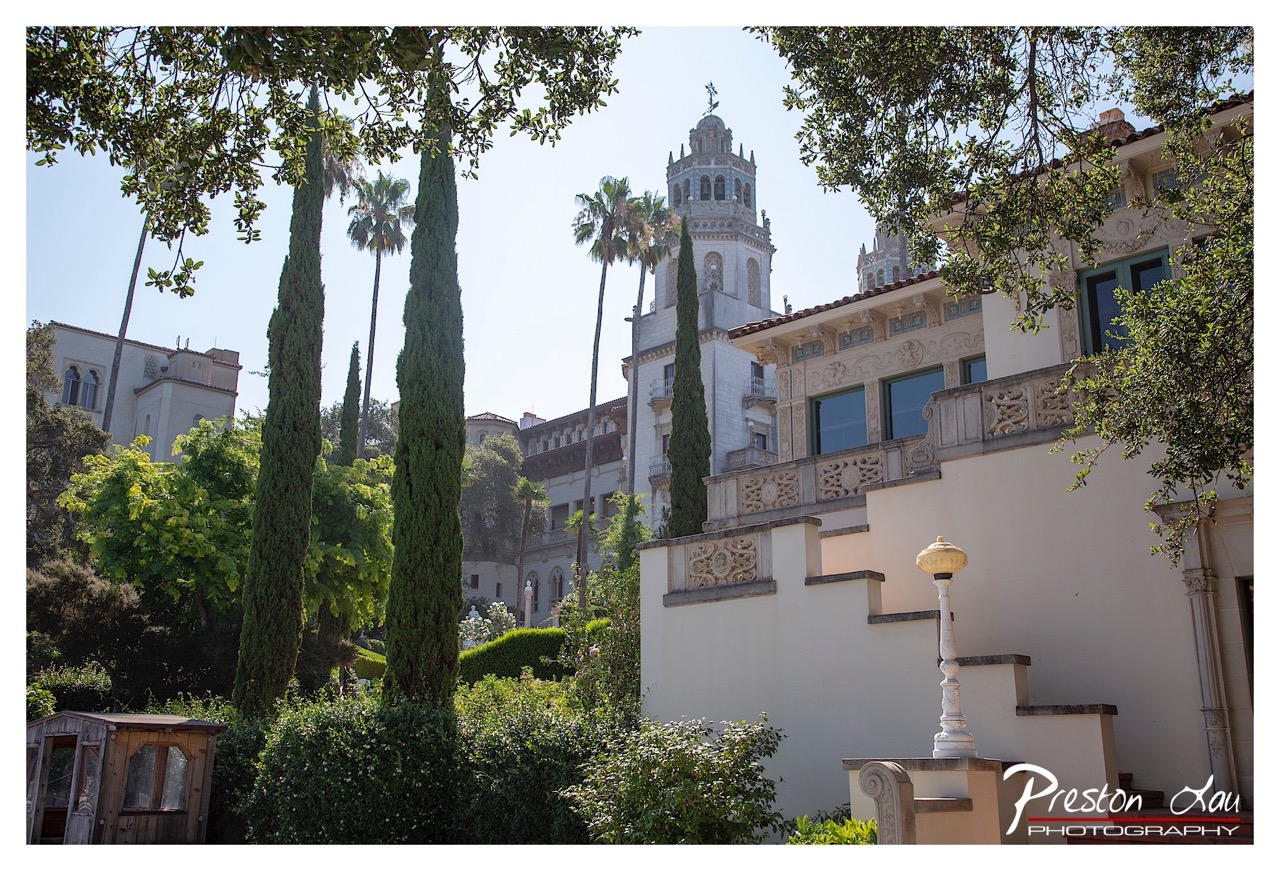

1. Overall Rating (0–10) — 7.5
This photograph captures the grandeur of a Mediterranean-style estate with a sense of serene elegance, where architecture and nature intertwine harmoniously. The composition draws the eye through layers of foliage and stonework toward the ornate tower, creating a narrative of history and refinement. While the image is visually rich, a slightly more balanced exposure and tighter framing would enhance its impact, elevating it from a lovely snapshot to a compelling architectural portrait.
2. Composition (0–10) — 7.0
The layered arrangement of trees, shrubs, and architecture creates depth, with the cypress trees framing the central tower. The inclusion of the small wooden shed in the lower-left corner slightly disrupts the aesthetic flow, while the diagonal lines of the stairs and railings guide the viewer’s gaze upward.
3. Lighting (0–10) — 8.0
Bright, natural daylight enhances the textures of the stonework and foliage, casting soft shadows that define form and volume. The high-angle sunlight highlights the intricate details of the building, though the sky is slightly overexposed, losing some detail in the clouds.
4. Color & Tone (0–10) — 7.5
The palette is dominated by warm cream tones of the building, contrasted with deep greens of the trees and the clear blue sky. The color balance feels natural and cohesive, with a slight warmth that enhances the Mediterranean atmosphere.
5. Creativity (0–10) — 7.0
The image successfully blends architectural grandeur with natural elements, evoking a sense of timelessness. The framing from a low vantage point adds drama, but the composition could benefit from a more intentional focus on the interplay between structure and landscape.
6. Technical Quality (0–10) — 8.0
Sharp focus across the frame, clean detail in the stonework and foliage, and well-managed exposure contribute to a technically strong image. The watermark is subtly placed and does not detract from the visual experience.
7. Emotional Impact (0–10) — 7.0
The photograph conveys a sense of peace and historical charm, inviting the viewer to imagine life within this elegant estate. The combination of light, architecture, and greenery evokes nostalgia and quiet wonder, though the emotional resonance is tempered by the slightly cluttered foreground.
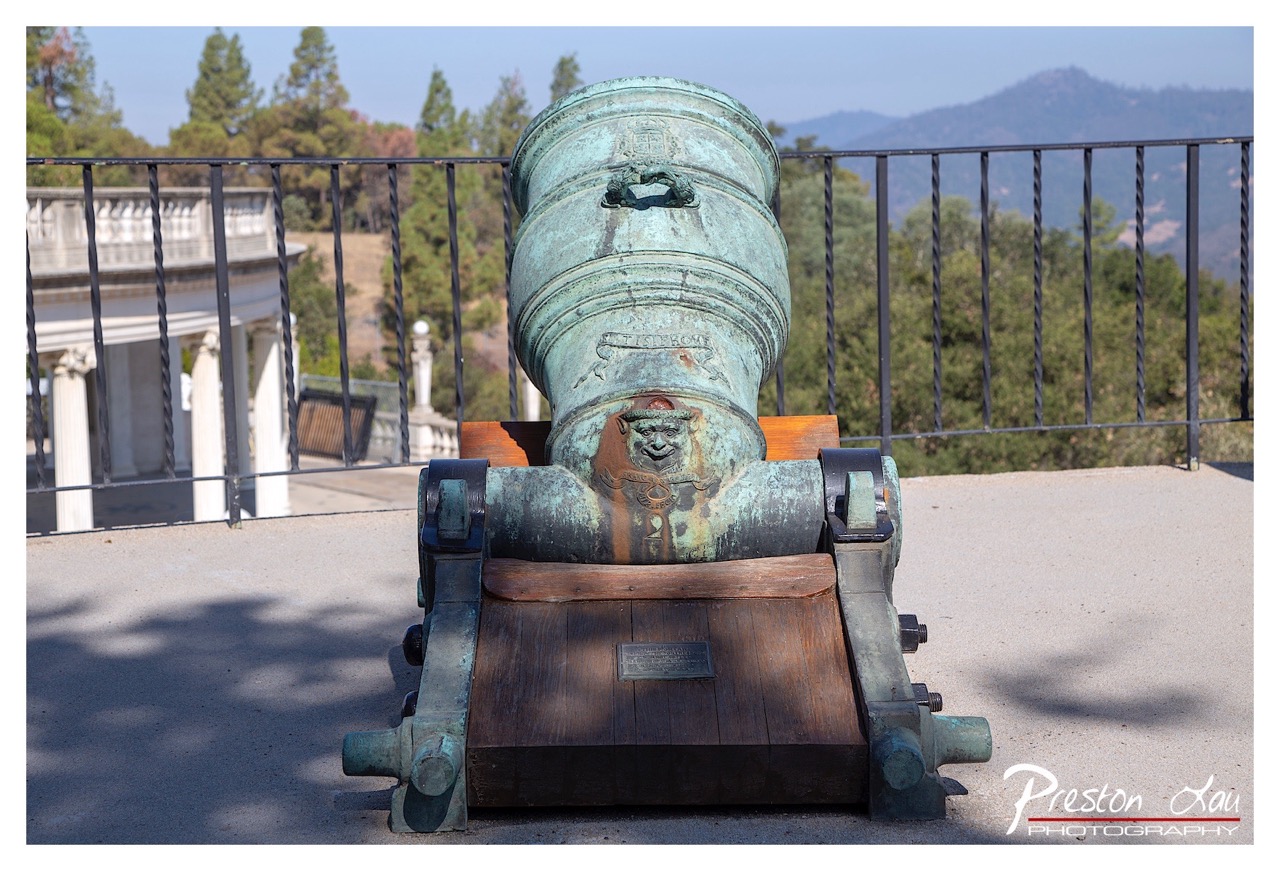

1. Overall Rating (0–10) — 7.0
This photograph captures a weathered cannon with a quiet dignity, its verdigris patina and ornate details telling a story of time and history. The setting—balcony railing, classical architecture, and distant hills—adds depth and context, grounding the subject in a place of reverence. While the composition is strong and the lighting clear, the image feels slightly restrained, as if it captures a moment more than it evokes an emotion.
2. Composition (0–10) — 7.5
The cannon is centered and framed by the railing, creating a balanced, symmetrical composition that draws the eye naturally to the subject. The inclusion of the classical structure and landscape in the background adds layers and context without overwhelming the focal point.
3. Lighting (0–10) — 8.0
Bright, even daylight illuminates the cannon clearly, highlighting its textures and patina without harsh shadows. The soft shadows cast by the railing add subtle depth and dimension.
4. Color & Tone (0–10) — 7.5
The muted greens of the patinated bronze contrast beautifully with the warm brown of the wooden carriage and the neutral tones of the stone and pavement. The distant hills add a soft blue-gray to the palette, enhancing the sense of space and calm.
5. Creativity (0–10) — 6.5
The image is straightforward in its documentation of a historical artifact, but the framing and timing elevate it beyond mere record-keeping. The juxtaposition of the ancient cannon with the modern balcony railing hints at a dialogue between past and present.
6. Technical Quality (0–10) — 8.5
Sharp focus, clean detail, and well-managed exposure demonstrate strong technical execution. The clarity of the metal’s texture and the inscription adds authenticity and visual interest.
7. Emotional Impact (0–10) — 6.0
The image evokes a sense of quiet reflection and historical weight, but its emotional resonance is more intellectual than visceral. It invites contemplation rather than stirring the heart.
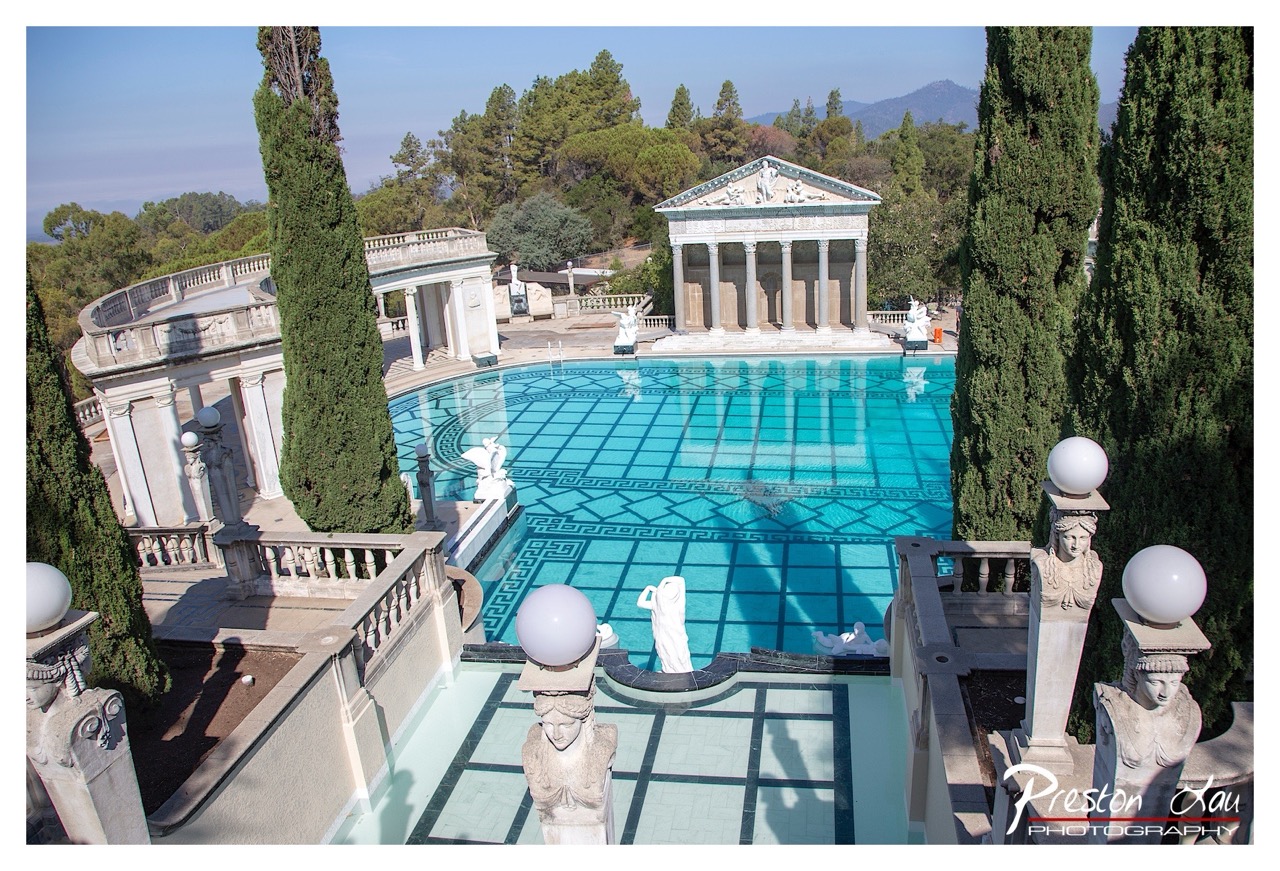

1. Overall Rating (0–10) — 8.0
This photograph captures the grandeur and symmetry of a classical-inspired garden pool, evoking a sense of timeless elegance and architectural harmony. The composition draws the eye toward the central temple-like structure, while the surrounding statues and cypress trees enhance the feeling of a curated, mythic landscape. The image successfully balances detail and atmosphere, though the slightly overexposed sky tempers its visual depth.
2. Composition (0–10) — 8.5
The high-angle perspective creates a balanced, symmetrical view that emphasizes the geometric design of the pool and surrounding structures. The statues and cypress trees frame the scene effectively, guiding the viewer’s gaze toward the central temple, while the foreground elements add depth and layering.
3. Lighting (0–10) — 7.5
Bright, natural daylight enhances the clarity and crispness of the scene, casting defined shadows that accentuate the architectural forms. However, the sky is slightly overexposed, losing subtle gradations in the clouds and reducing atmospheric nuance.
4. Color & Tone (0–10) — 8.0
The vibrant turquoise of the pool contrasts beautifully with the neutral stone and deep green of the cypress trees, creating a rich, harmonious palette. The cool tones dominate, reinforcing the classical, serene mood, while the white marble sculptures provide visual relief and balance.
5. Creativity (0–10) — 8.0
The image presents a visually striking and conceptually cohesive vision of classical idealism, blending architecture, nature, and sculpture into a unified aesthetic. The choice of angle and framing elevates the scene beyond mere documentation into an artistic interpretation of grandeur and order.
6. Technical Quality (0–10) — 8.5
The image is sharp and detailed, with clean focus across the entire frame. The exposure is well-handled overall, though the sky’s brightness slightly compromises dynamic range. Post-processing appears controlled, preserving texture and clarity without artificial smoothing.
7. Emotional Impact (0–10) — 7.5
The photograph conveys a sense of awe and tranquility, inviting the viewer to imagine a world of refined beauty and quiet contemplation. While the scene is majestic, its formal nature keeps the emotional connection at a respectful distance, leaving the viewer as an observer of an idealized past.
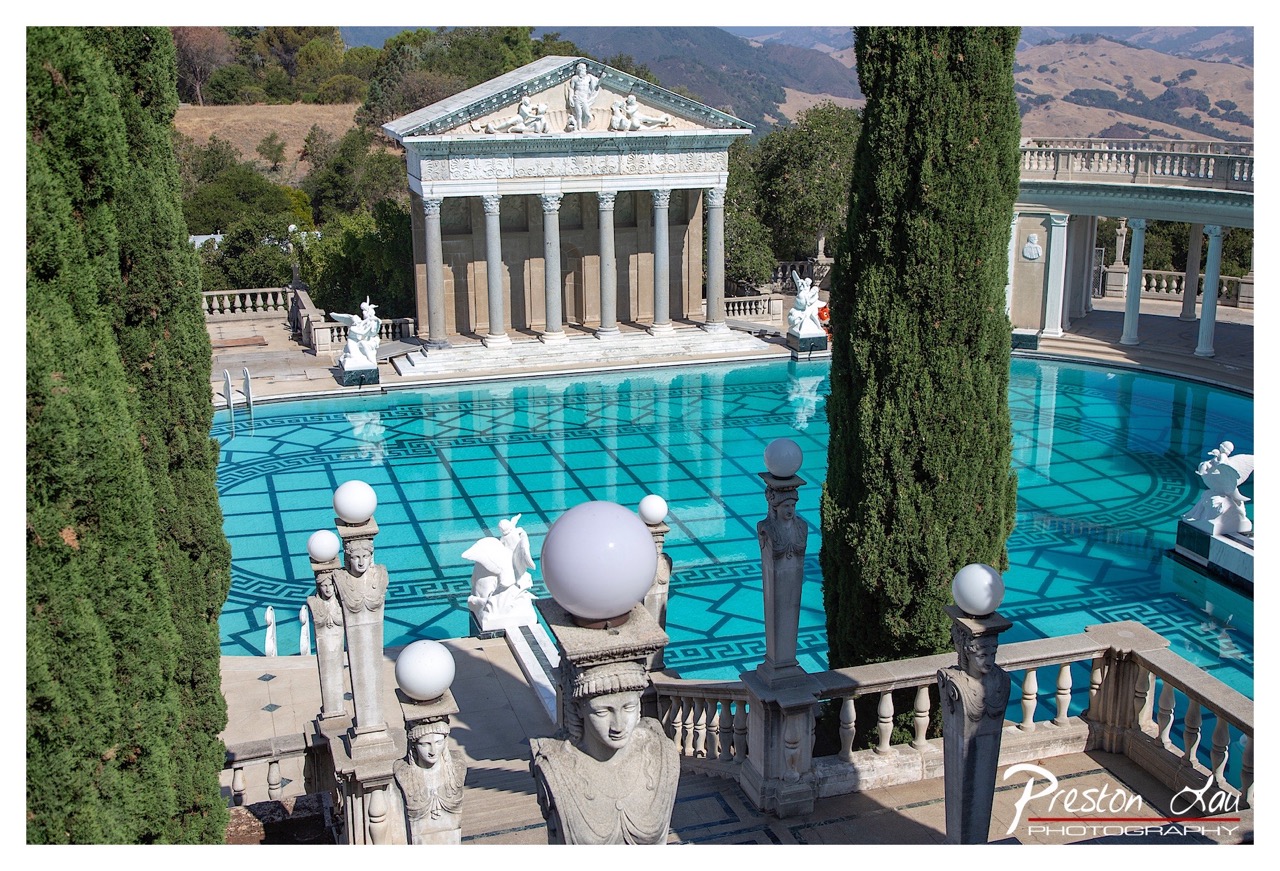

1. Overall Rating (0–10) — 8.0
This photograph captures the grandeur and symmetry of a classical-style estate, where architecture and nature converge in a harmonious display of opulence. The interplay of the turquoise pool, marble columns, and sculpted figures evokes a sense of timeless elegance, while the surrounding hills provide a natural contrast that grounds the scene. Though the composition is rich with detail, the sheer density of elements risks overwhelming the viewer, slightly diminishing the clarity of the image’s focal point.
2. Composition (0–10) — 8.0
The elevated perspective and symmetrical framing guide the eye toward the central temple-like structure, creating a sense of balance and order. The tall cypress trees on either side act as natural framing devices, while the descending staircase and pool tiles add leading lines that enhance depth and visual flow.
3. Lighting (0–10) — 8.5
Bright, even daylight enhances the clarity and crispness of the scene, highlighting the textures of the marble and the vivid color of the pool. The soft shadows beneath the columns and statues add dimension without obscuring details, and the high contrast between light and shade accentuates the architectural form.
4. Color & Tone (0–10) — 8.0
The vibrant turquoise of the pool stands out against the neutral tones of the stone and the lush green of the cypress trees, creating a visually striking palette. The overall tone is bright and clean, with a balanced saturation that feels natural and inviting, enhancing the classical aesthetic.
5. Creativity (0–10) — 7.5
The image successfully conveys a sense of mythic grandeur, drawing on classical motifs to create a narrative of cultural reverence. The placement of sculptures and the deliberate use of symmetry suggest a curated environment, though the scene feels more like a homage to classical ideals than a truly original artistic statement.
6. Technical Quality (0–10) — 8.5
The photograph is sharp and detailed, with excellent clarity across the frame. The focus is consistent, and the exposure is well-managed, preserving detail in both highlights and shadows. The watermark is discreet and does not detract from the image’s overall presentation.
7. Emotional Impact (0–10) — 7.5
The image evokes awe and tranquility, inviting the viewer to imagine a world of leisure and artistic refinement. The stillness of the scene, combined with the timeless design, creates a contemplative mood—though the lack of human presence tempers the emotional immediacy, leaving the viewer as a quiet observer rather than an active participant.
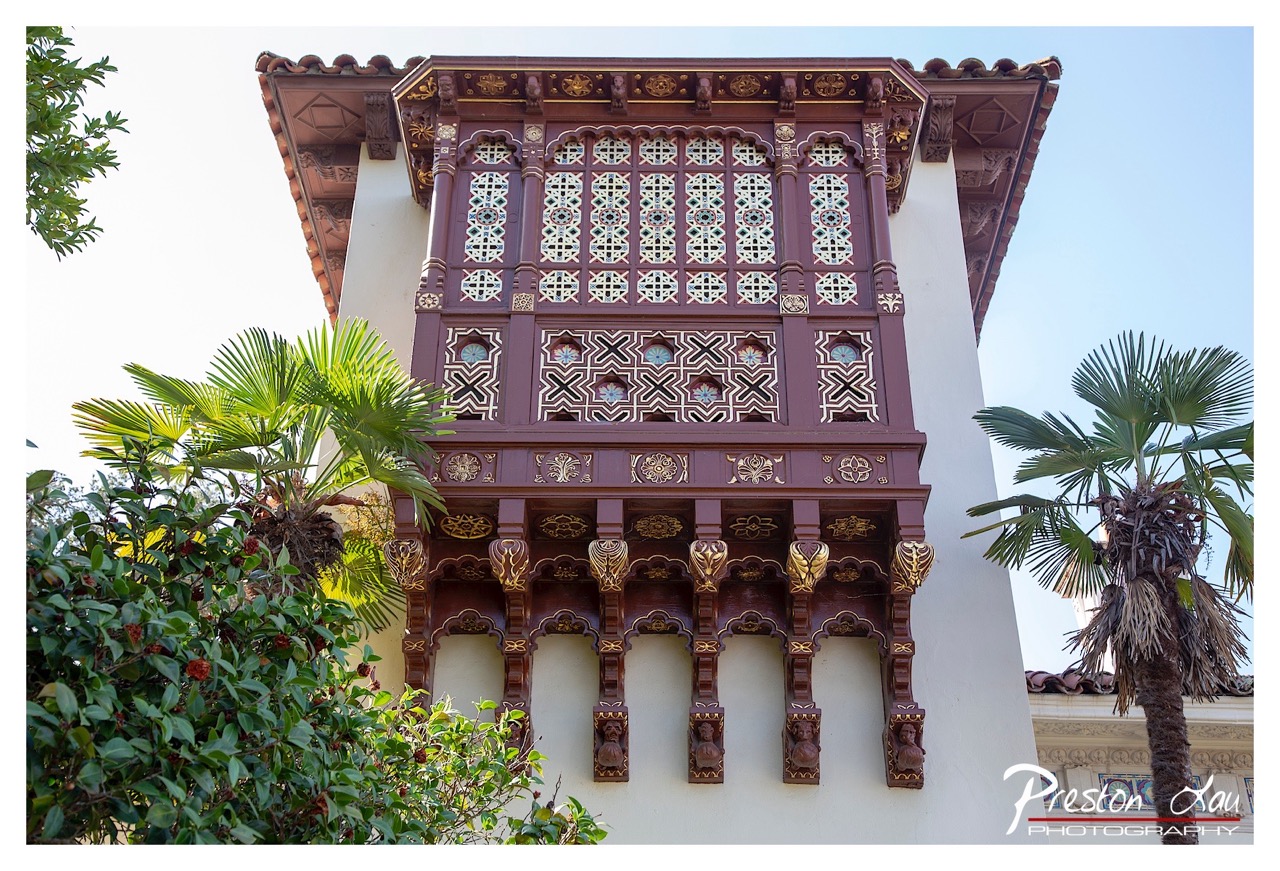

1. Overall Rating (0–10) — 8.0
This photograph captures the ornate elegance of a Moorish-inspired architectural detail, where intricate woodwork and vibrant craftsmanship stand in striking contrast to the soft, natural backdrop of palm fronds and clear sky. The composition balances cultural richness with environmental harmony, drawing the eye to the layered patterns and golden accents. While the image is visually compelling, a more dynamic angle or tighter framing might elevate its narrative power beyond a mere architectural record.
2. Composition (0–10) — 7.5
The low-angle perspective emphasizes the verticality and grandeur of the structure, while the framing with palm trees on either side creates a natural symmetry. The inclusion of foliage adds depth and context, though the upper portion of the frame feels slightly unbalanced due to the overexposed sky.
3. Lighting (0–10) — 7.0
Natural daylight illuminates the facade evenly, highlighting the textures and gold accents without harsh shadows. The bright sky, however, slightly washes out the top of the frame, reducing detail in the uppermost architectural elements.
4. Color & Tone (0–10) — 8.0
The rich maroon of the woodwork contrasts beautifully with the white stucco and the green of the palms, while the golden embellishments add warmth and richness. The palette is vibrant yet harmonious, with a balanced tonal range that enhances the visual appeal.
5. Creativity (0–10) — 8.5
The photographer captures a moment of cultural beauty with an artistic eye, emphasizing the intricate craftsmanship and blending it seamlessly with the surrounding tropical environment. The choice to frame the structure within nature adds a layer of storytelling, suggesting a fusion of tradition and place.
6. Technical Quality (0–10) — 8.5
Sharp focus across the central architectural elements ensures clarity in the detailed carvings, and the depth of field is well-managed. The exposure is largely accurate, with only minor overexposure in the sky, which is a common challenge in outdoor architectural photography.
7. Emotional Impact (0–10) — 7.5
The image evokes a sense of awe and appreciation for cultural heritage, inviting the viewer to pause and admire the artistry. The combination of structure and nature creates a tranquil, almost reverent atmosphere, though the emotional resonance is slightly restrained by the image’s documentary tone.
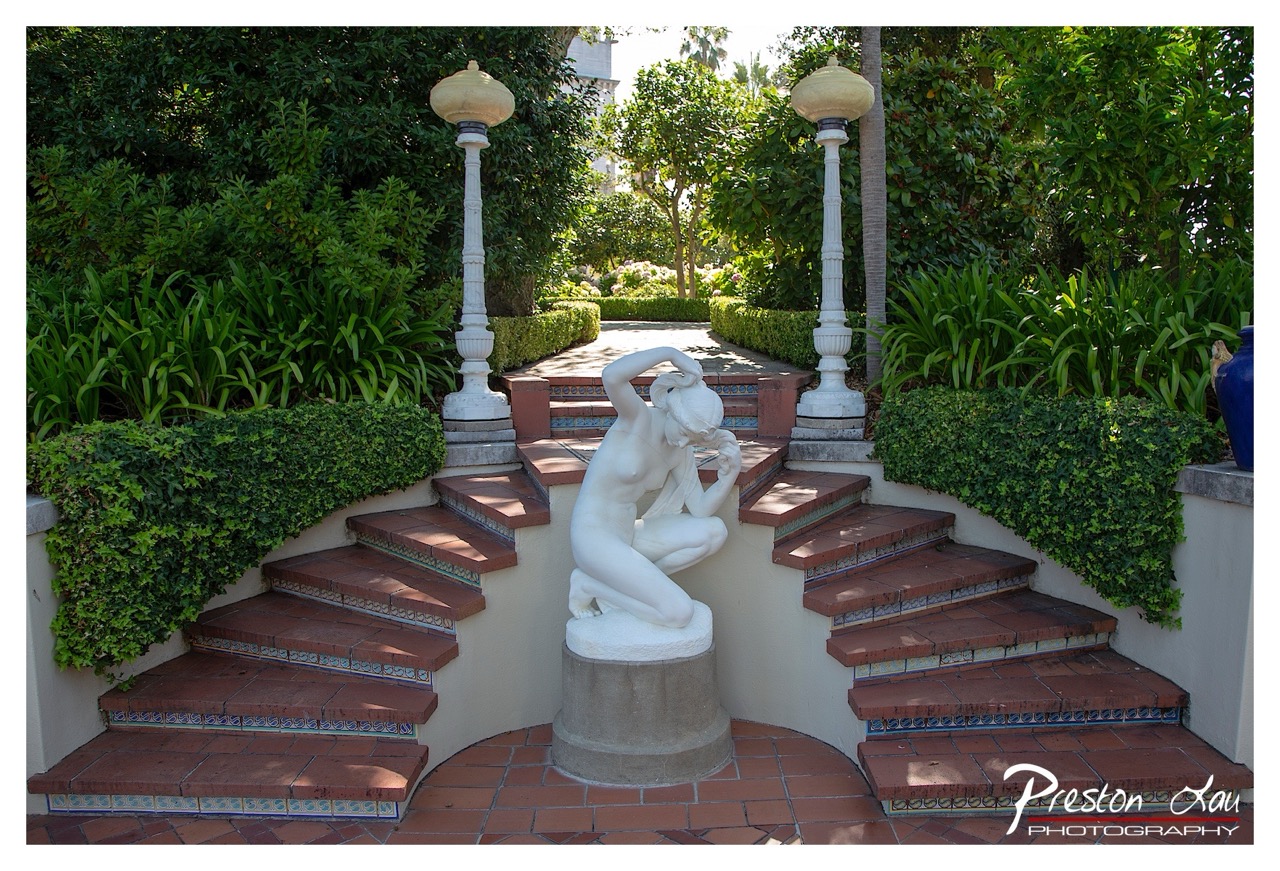

1. Overall Rating (0–10) — 7.5
This photograph captures the tranquil elegance of a formal garden, where classical sculpture and lush greenery converge in harmonious balance. The composition draws the eye along the curving staircase toward a sunlit path, evoking a sense of quiet discovery. While the image is rich in detail and atmosphere, the slight overexposure in the background and the intrusive blue vase on the right edge slightly disrupt the visual narrative.
2. Composition (0–10) — 8.0
The symmetrical framing centers the sculpture and creates a strong leading line with the staircase, guiding the viewer’s gaze into the garden. The use of depth and layered foliage adds dimension, though the off-center placement of the blue vase on the right slightly disrupts the balance.
3. Lighting (0–10) — 7.5
Natural sunlight illuminates the scene with a soft, diffused quality, highlighting the textures of the stone and tile. The dappled light on the steps and the gentle shadows under the hedges enhance depth and realism, though the sky is slightly overexposed, losing some detail.
4. Color & Tone (0–10) — 7.0
The palette is dominated by earthy terracotta and verdant greens, creating a warm, natural harmony. The white marble sculpture stands out with crisp contrast, though the presence of the blue vase introduces an unexpected accent that feels slightly out of place.
5. Creativity (0–10) — 7.5
The photograph successfully captures the romanticism of a classical garden, blending architecture, sculpture, and nature into a cohesive story. The choice to frame the scene through the staircase adds a sense of invitation and discovery, elevating it beyond a simple architectural shot.
6. Technical Quality (0–10) — 8.0
The image is sharp and detailed, with clear focus on the central sculpture and surrounding textures. The exposure is well-managed overall, though the highlights in the background are slightly blown out.
7. Emotional Impact (0–10) — 7.0
The photograph evokes a sense of peace and timelessness, inviting contemplation and quiet admiration. The viewer is drawn into a moment of stillness, as if stepping into a secluded garden sanctuary, though the subtle distractions prevent a fully immersive experience.
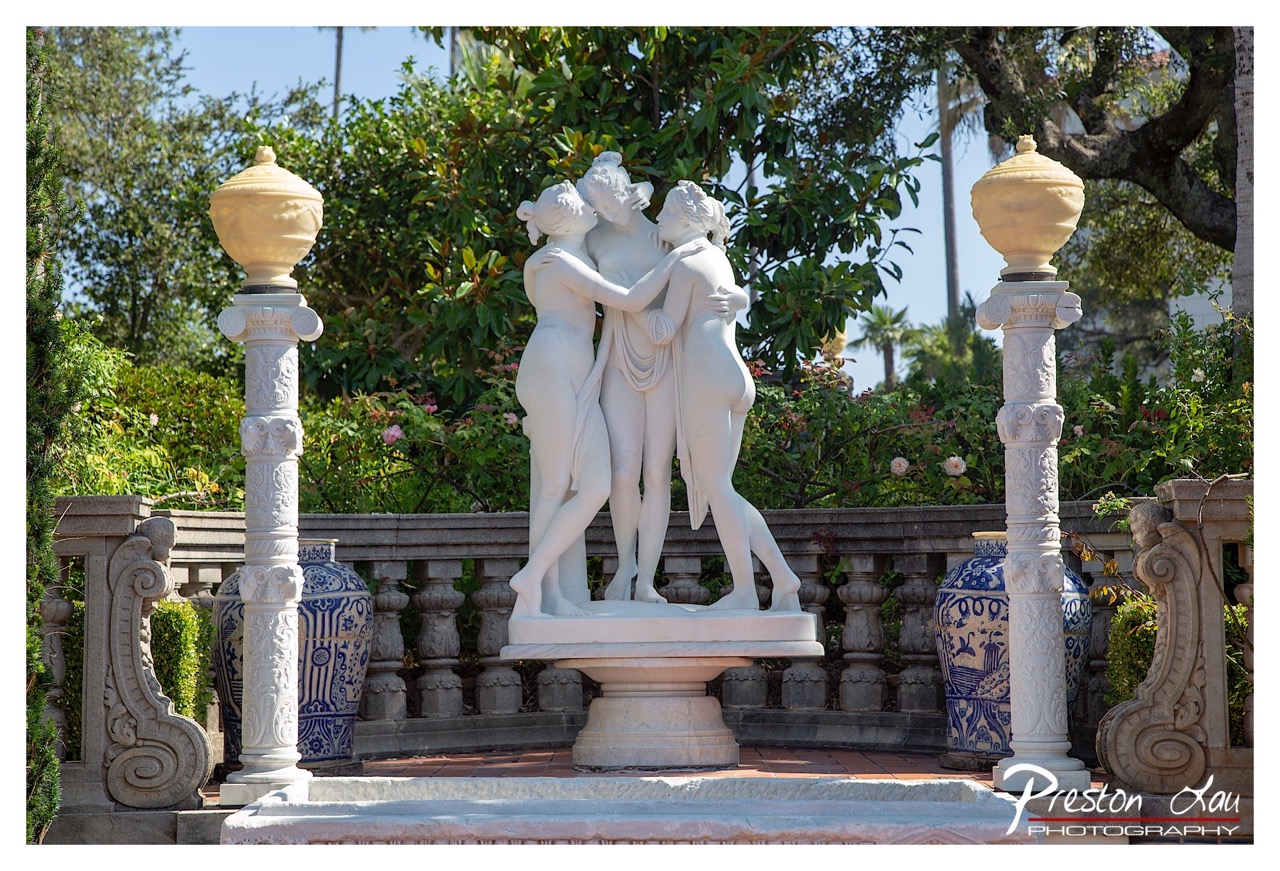

1. Overall Rating (0–10) — 8.0
This photograph captures the serene elegance of a classical sculpture nestled within a lush, sun-drenched garden, evoking a sense of timeless beauty and refined artistry. The interplay between the white marble figures and the vibrant greenery creates a harmonious balance, while the ornate vases and balustrades add layers of cultural richness. The image succeeds in conveying both the sculpture’s grace and the garden’s opulent atmosphere, though the slightly overexposed sky detracts from the overall subtlety.
2. Composition (0–10) — 8.0
The sculpture is centered and framed symmetrically by the flanking columns and vases, creating a strong sense of balance and visual order. The use of leading lines from the balustrade and columns draws the eye toward the central subject, enhancing focus and depth.
3. Lighting (0–10) — 7.5
Bright, natural daylight illuminates the scene, highlighting the texture and form of the marble. The strong sunlight creates crisp highlights and deep shadows, adding dimension, though the sky is slightly overexposed, losing detail in the upper portion.
4. Color & Tone (0–10) — 7.5
The palette is rich and varied, with the white marble contrasting beautifully against the deep blues and whites of the porcelain vases and the lush greens of the foliage. The warm tones of the stone and terracotta ground enhance the Mediterranean feel, though the high contrast slightly flattens some midtones.
5. Creativity (0–10) — 8.0
The photographer has captured a moment that blends classical art with natural beauty in a way that feels both reverent and visually engaging. The careful arrangement of elements suggests intentional storytelling, celebrating the fusion of human craftsmanship and nature.
6. Technical Quality (0–10) — 8.5
The image is sharp and well-focused, with excellent detail in the marble sculpture and ornamental columns. The depth of field is appropriately managed, keeping the main subject crisp while gently blurring the background to emphasize the sculpture.
7. Emotional Impact (0–10) — 8.0
The photograph evokes a sense of tranquility and wonder, inviting the viewer to pause and reflect on the beauty of classical art and the serenity of a sunlit garden. The harmonious composition and warm light foster a contemplative mood, making the scene feel both grand and intimate.
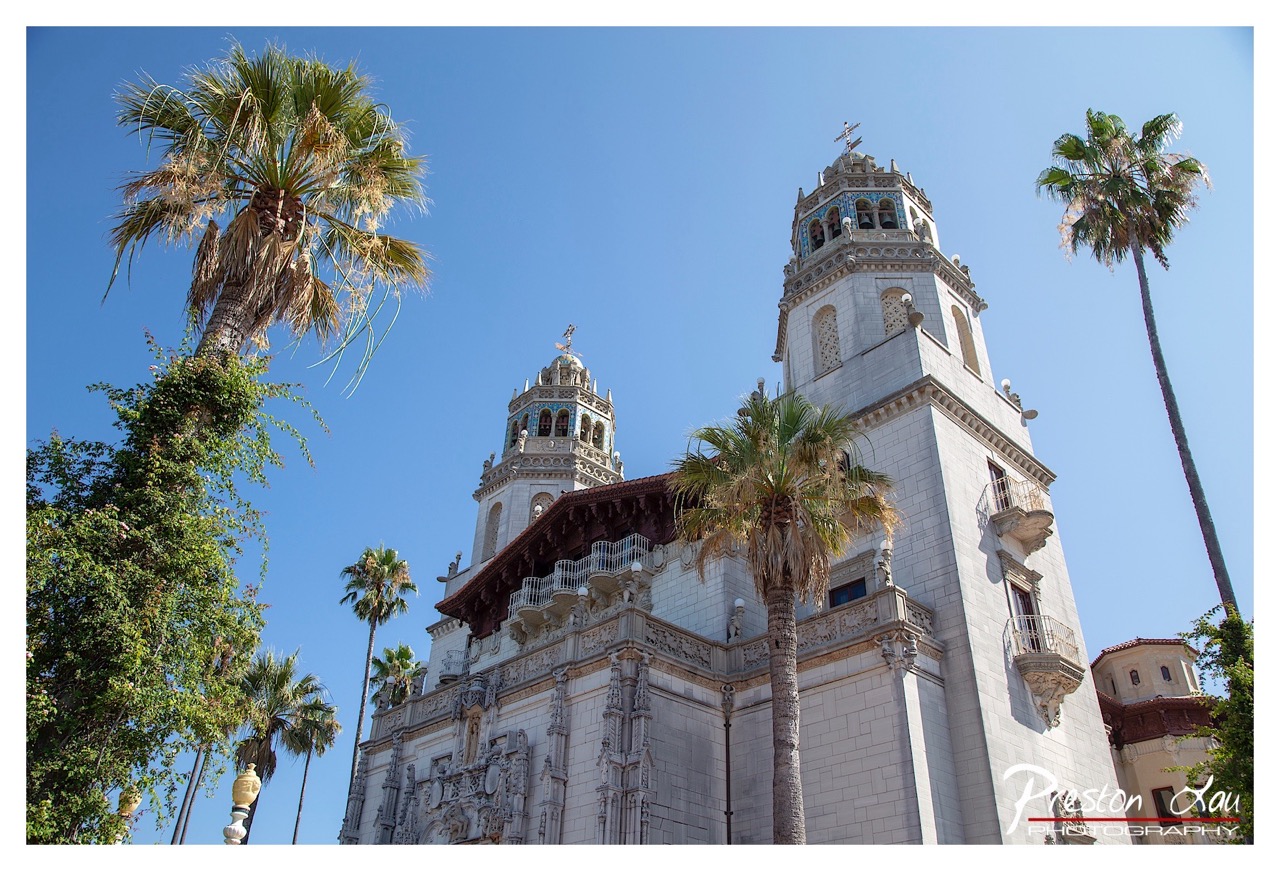

1. Overall Rating (0–10) — 8.0
This photograph captures the grandeur of a Spanish Colonial Revival structure with a striking sense of scale and place, framed by palm trees against a flawless blue sky. The low-angle perspective emphasizes the architectural majesty, while the vibrant contrast between the white stonework and the lush greenery enhances the image’s visual dynamism. A slight overexposure in the sky tempers its perfection, but the overall composition is both celebratory and evocative of Southern California’s distinctive aesthetic.
2. Composition (0–10) — 8.5
The low-angle view creates a dramatic sense of height and power, with the towers rising diagonally into the frame. Palm trees on both sides act as natural framing elements, guiding the eye toward the central architecture. The inclusion of foliage in the foreground adds depth, though the right-side palm slightly overpowers the balance.
3. Lighting (0–10) — 8.0
Bright, direct sunlight enhances the texture and detail of the building’s stonework, casting crisp shadows that emphasize its ornate features. The high-contrast lighting accentuates the architectural complexity, though the sky is slightly blown out, losing some detail in the brightest area.
4. Color & Tone (0–10) — 8.5
The rich azure of the sky provides a bold backdrop that makes the white stone pop, while the green of the palms adds a natural contrast. The warm tones of the roof tiles and subtle gold accents in the architecture enrich the palette, creating a balanced and inviting color scheme.
5. Creativity (0–10) — 8.0
The photographer uses a classic architectural perspective to highlight the building’s cultural and historical significance. The inclusion of palm trees grounds the image in its location, creating a narrative of place that feels both timeless and distinctly Californian.
6. Technical Quality (0–10) — 8.5
Sharp focus across the frame ensures clarity in the building’s intricate details. The exposure is well-managed overall, with only minor loss in the sky highlights. The watermark is subtle and professionally placed.
7. Emotional Impact (0–10) — 8.0
The image evokes a sense of awe and nostalgia, inviting the viewer to imagine the history and stories behind the structure. The bright, sunny atmosphere and elegant design create a feeling of warmth, pride, and timeless beauty.
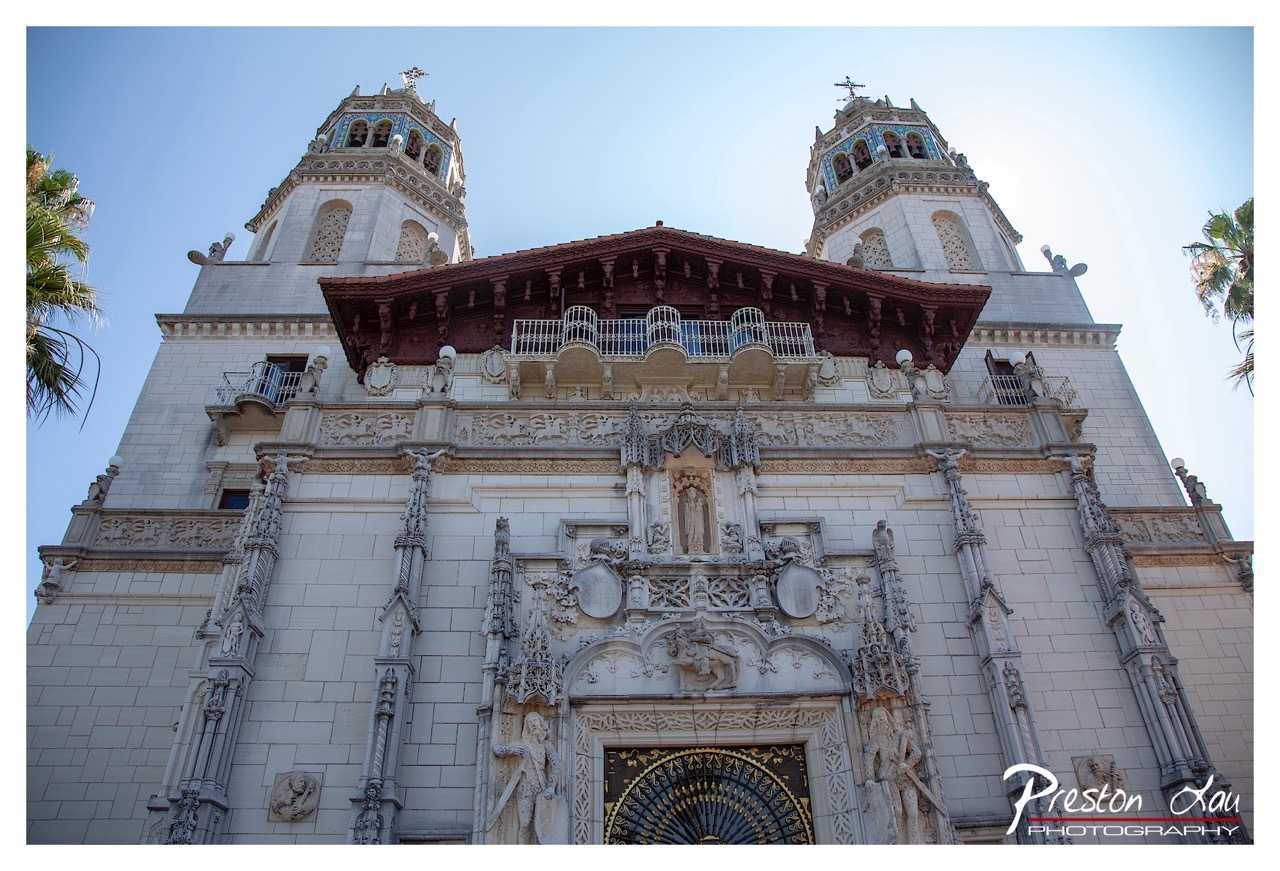

1. Overall Rating (0–10) — 8.0
This photograph captures the grandeur and intricate craftsmanship of a historic architectural masterpiece, where light and shadow emphasize its ornate details. The low-angle perspective amplifies the building’s verticality and majesty, drawing the viewer into its opulent narrative. While the composition is strong and the subject compelling, the image slightly underplays the emotional resonance of the structure by prioritizing documentation over atmosphere.
2. Composition (0–10) — 8.5
The low-angle framing enhances the building’s imposing presence, with symmetrical placement of the twin towers creating visual balance. The inclusion of palm fronds at the edges adds natural framing and contextual depth, though the right side feels marginally more crowded than the left.
3. Lighting (0–10) — 7.5
Bright, direct sunlight illuminates the facade, highlighting the sculptural details and textures. The shadows cast by the overhangs and columns add depth and dimension, though the high contrast slightly flattens some of the finer carvings.
4. Color & Tone (0–10) — 7.0
The palette is dominated by soft whites and grays of the stonework, contrasted by the deep red of the roof and the blue of the sky. While harmonious, the color treatment is somewhat restrained, lacking the warmth or saturation that could further enhance the richness of the architecture.
5. Creativity (0–10) — 8.0
The choice of perspective and framing elevates the subject beyond a simple architectural record, transforming it into a statement of cultural and artistic significance. The integration of natural elements like the palm trees adds a subtle layer of place-specific context.
6. Technical Quality (0–10) — 8.5
The image is sharp and detailed, with precise focus on the central facade. The exposure is well-managed, preserving texture and clarity throughout the frame, even under bright daylight.
7. Emotional Impact (0–10) — 7.5
The photograph evokes a sense of awe and reverence for the craftsmanship and history embodied in the structure. While it invites admiration, the emotional pull is more intellectual than visceral, leaving room for deeper narrative engagement.
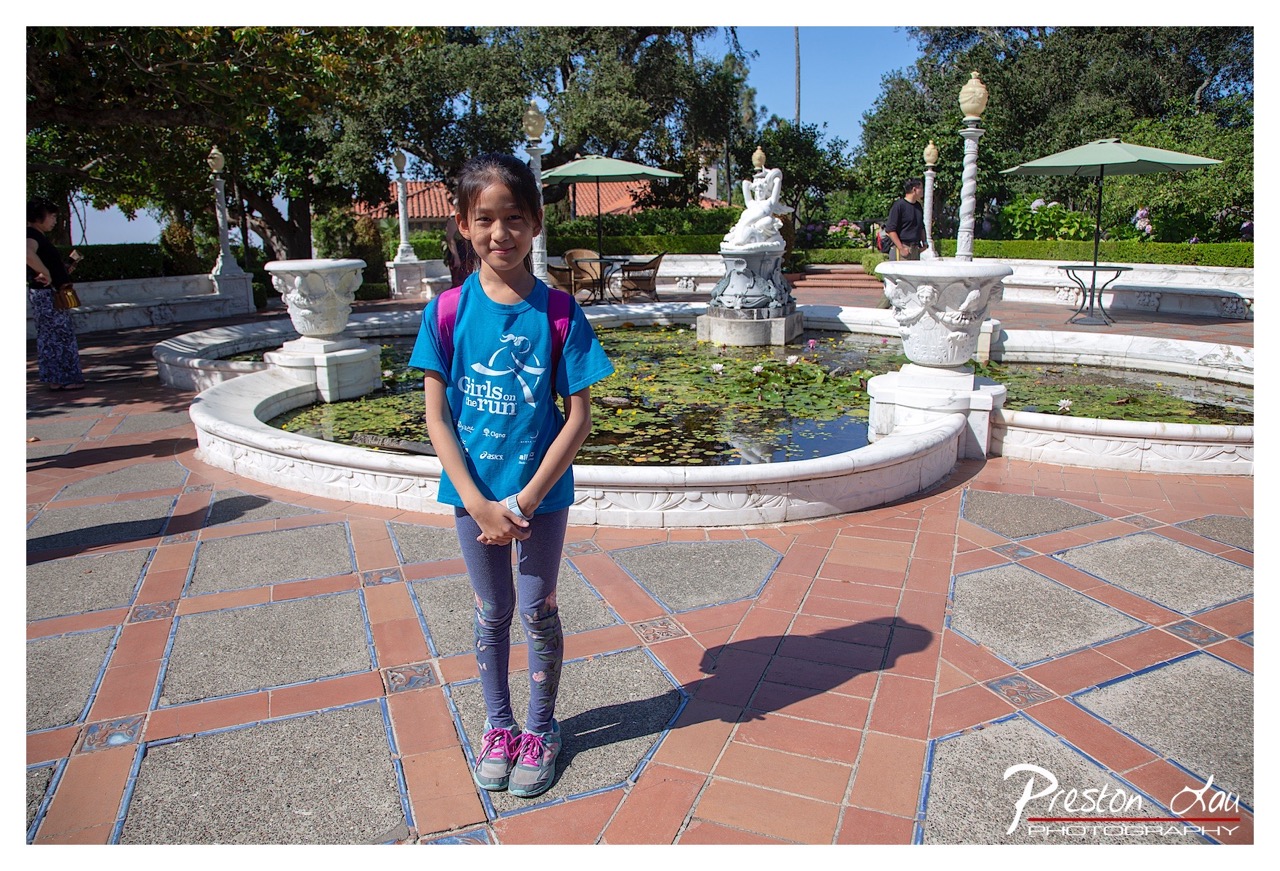

1. Overall Rating (0–10) — 7.0
This photograph captures a bright, sunlit moment in a lush garden setting, where a young girl stands confidently in front of an ornate fountain. The image balances personal warmth with architectural elegance, creating a sense of joyful occasion. While the composition is strong and the lighting is vibrant, the scene’s inherent busyness slightly dilutes the focus on the subject, leaving room for greater narrative clarity.
2. Composition (0–10) — 7.5
The subject is centered and well-framed, with the fountain and surrounding architecture providing a rich, layered backdrop. The diagonal lines of the tile pattern guide the eye toward the girl, enhancing visual flow, though the background activity adds subtle distractions.
3. Lighting (0–10) — 8.0
Bright, natural sunlight enhances the scene’s clarity and warmth, casting soft shadows that define form and texture. The high contrast between light and shade adds depth without obscuring detail.
4. Color & Tone (0–10) — 7.5
The palette is rich and harmonious, with the blue of the girl’s shirt complementing the greens of the trees and the earthy tones of the terracotta tiles. The white stone of the fountain provides a clean contrast, enhancing visual balance.
5. Creativity (0–10) — 6.5
The image tells a simple story of a child’s moment in a beautiful setting, but the approach is more documentary than artistic. While the scene is visually engaging, it lacks a distinctive conceptual or emotional twist.
6. Technical Quality (0–10) — 8.5
Sharp focus, clean detail, and accurate exposure reflect strong technical execution. The image is well-captured, with minimal noise and excellent clarity throughout.
7. Emotional Impact (0–10) — 7.0
The girl’s gentle smile and relaxed posture convey a quiet sense of pride and contentment. The setting adds a layer of serenity, inviting the viewer to share in a peaceful, sun-drenched memory.
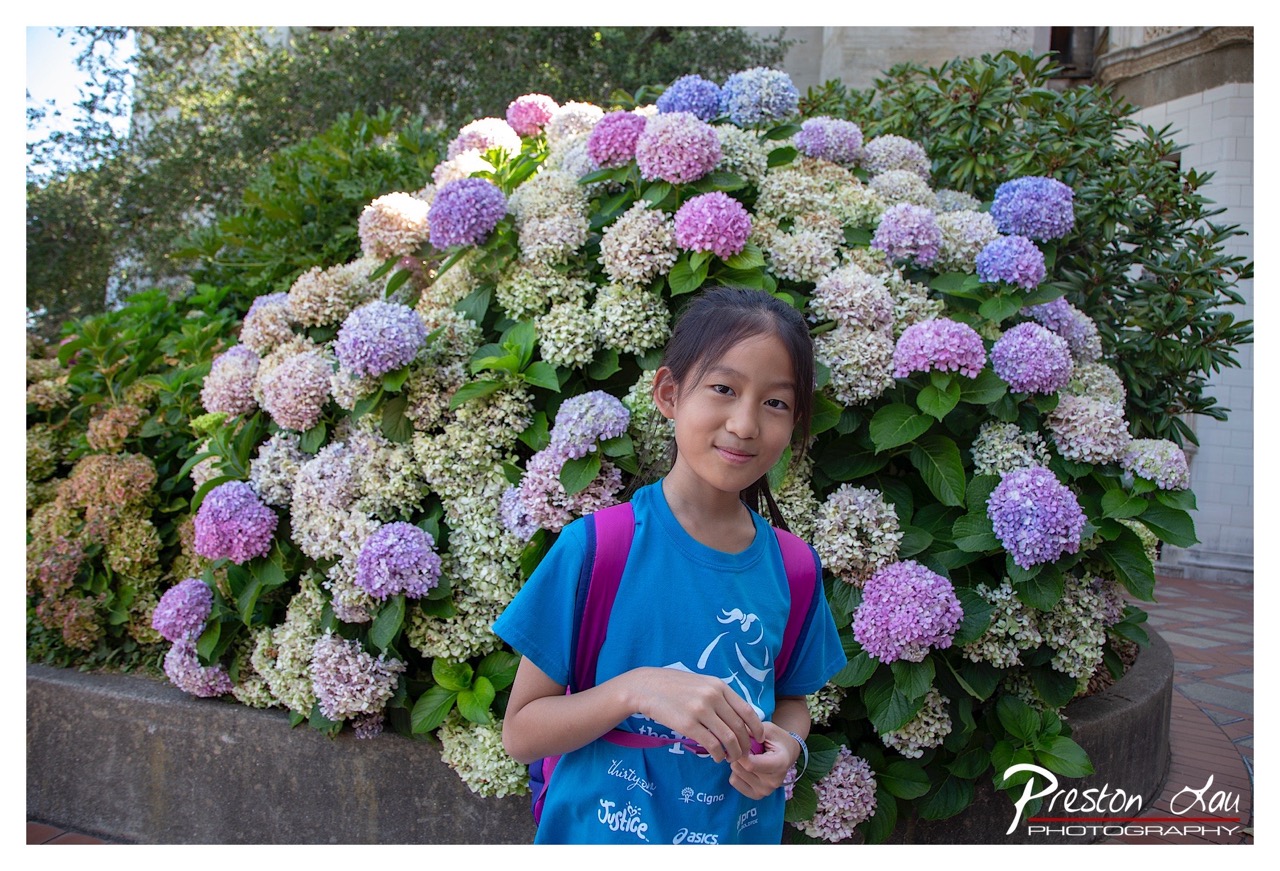

1. Overall Rating (0–10) — 7.5
This portrait captures a tender moment of youthful innocence framed by a lush, vibrant floral display, creating a harmonious blend of human warmth and natural beauty. The girl’s gentle smile and the soft, diffused light lend a serene, almost painterly quality to the scene, though the composition’s slight clutter and overexposed highlights temper its overall impact. The image feels both personal and inviting, offering a snapshot of a fleeting, joyful moment.
2. Composition (0–10) — 7.0
The subject is well-placed in the lower center, creating a natural focal point against the dense floral backdrop. The large hydrangea bush fills the frame effectively, adding depth and texture, though the slight asymmetry and visible edge of the planter introduce a minor visual distraction.
3. Lighting (0–10) — 7.5
Soft, natural light enhances the scene, with gentle highlights on the flowers and the girl’s face. A slight overexposure in the upper left suggests a bright sky, but it does not overpower the subject, preserving the overall softness and balance.
4. Color & Tone (0–10) — 8.0
The palette is rich and harmonious, with the cool purples and pinks of the hydrangeas complementing the girl’s blue shirt. The green foliage adds contrast, and the tonal range is well-managed, creating a fresh and lively visual atmosphere.
5. Creativity (0–10) — 7.0
The combination of a child and a vibrant floral arrangement evokes a sense of innocence and renewal. While the concept is familiar, the execution feels authentic and emotionally resonant, capturing a quiet moment with a thoughtful eye.
6. Technical Quality (0–10) — 8.0
Sharp focus on the subject, clean detail in the flowers and clothing, and a well-managed depth of field contribute to a technically strong image. The watermark is subtle and does not detract from the composition.
7. Emotional Impact (0–10) — 8.0
The photograph radiates warmth and gentleness, evoking a sense of peace and quiet joy. The girl’s calm expression and the lush surroundings combine to create a deeply relatable and emotionally engaging moment.
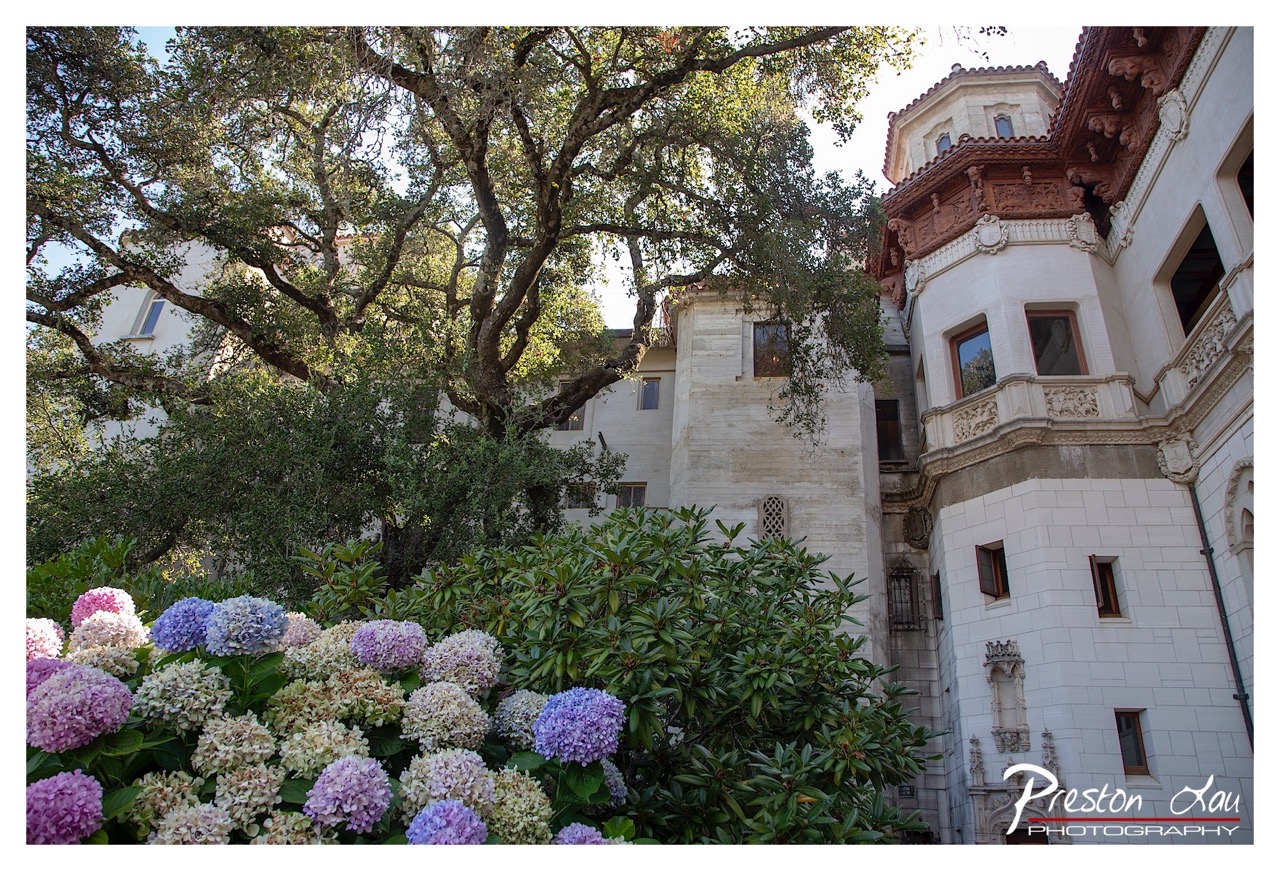

1. Overall Rating (0–10) — 7.5
This photograph captures a harmonious blend of natural beauty and architectural grandeur, where the vibrant hydrangeas in the foreground contrast elegantly with the ornate, sunlit stone façade. The composition balances lush greenery and intricate stonework, evoking a sense of timelessness and refined romance. While the image is visually rich, a slightly more deliberate framing could enhance the narrative focus on the interplay between nature and the man-made structure.
2. Composition (0–10) — 7.0
The low-angle perspective draws the eye upward, emphasizing the height and detail of the building, while the hydrangeas anchor the frame and provide a natural foreground. The large tree on the left creates a dynamic diagonal that leads the eye into the scene, though the right side feels slightly crowded by the building’s complexity.
3. Lighting (0–10) — 8.0
Soft, directional sunlight filters through the tree canopy, casting dappled light across the hydrangeas and highlighting the textures of the stone. The warm glow enhances the architectural details without creating harsh shadows, contributing to the image’s serene and inviting mood.
4. Color & Tone (0–10) — 8.0
The palette is rich and natural, with soft purples, pinks, and whites of the hydrangeas complementing the creamy whites and earthy tones of the building. The contrast between the vivid blooms and the muted stonework adds depth and visual interest, while the overall tone remains cohesive and balanced.
5. Creativity (0–10) — 7.5
The juxtaposition of organic forms and classical architecture is compelling, suggesting a story of history and cultivation. The photographer’s choice to include the tree and flowers as foreground elements adds narrative depth, transforming a simple architectural shot into a layered, evocative scene.
6. Technical Quality (0–10) — 8.5
The image is sharp and well-focused, with excellent detail in both the flowers and the building. The exposure is balanced, preserving highlights in the sky and shadows in the foliage, and the watermark is discreetly placed without distracting from the composition.
7. Emotional Impact (0–10) — 7.0
The photograph evokes a sense of peace and wonder, inviting the viewer to imagine the quiet history of the place. The interplay of light, color, and form creates a contemplative mood, though the emotional resonance is slightly restrained by the complexity of the background elements.
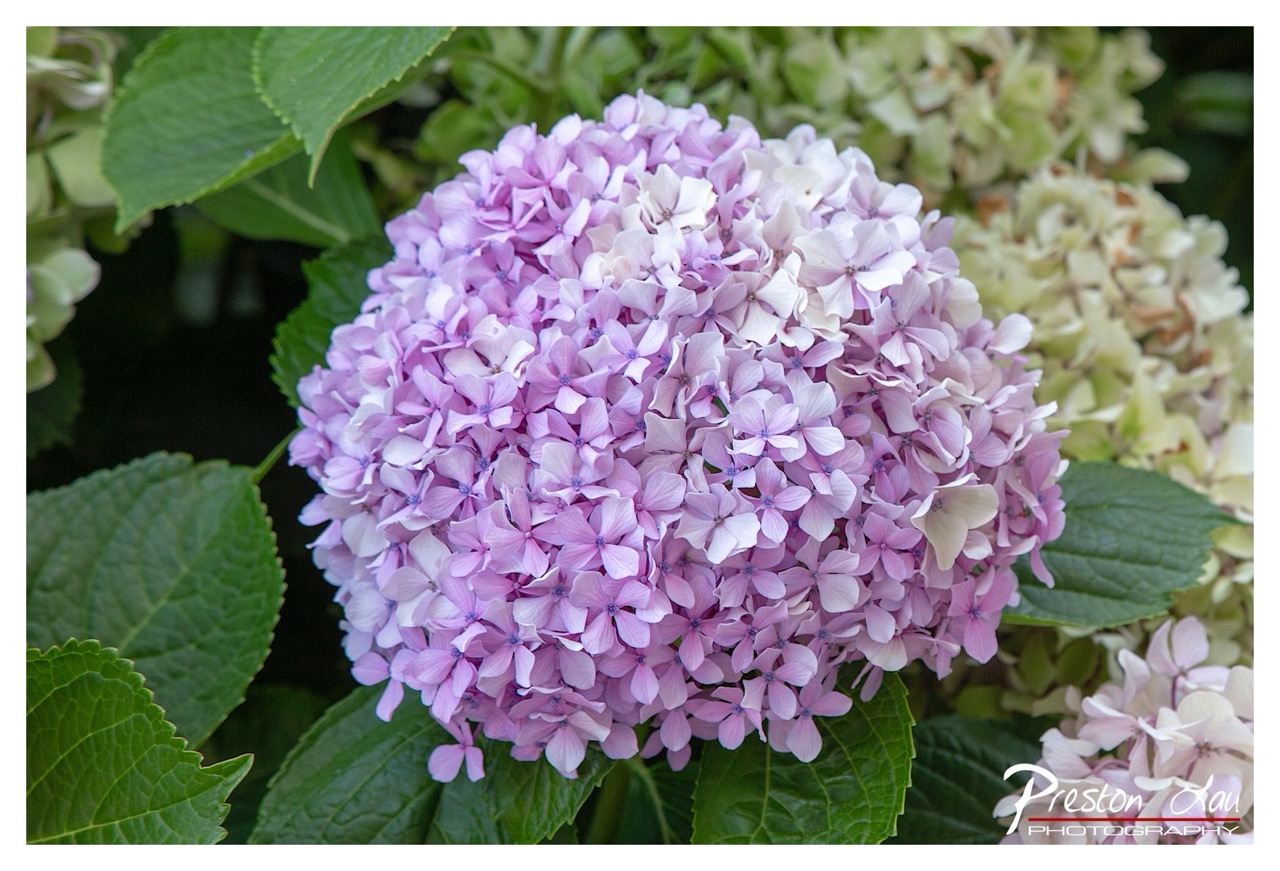

1. Overall Rating (0–10) — 7.5
This photograph captures the delicate beauty of a hydrangea bloom with a soft, dreamy quality that draws the eye into its intricate layers. The vibrant purple-pink hue of the central flower contrasts elegantly with the surrounding green foliage, creating a natural harmony that feels both serene and rich in texture. While the image is visually pleasing, it could benefit from slightly more depth and dynamic contrast to elevate its emotional resonance beyond mere documentation.
2. Composition (0–10) — 7.0
The flower is well-centered, creating a balanced and focused composition. The framing includes enough surrounding foliage to provide context, though the background blooms are slightly distracting, pulling attention from the main subject.
3. Lighting (0–10) — 7.5
Soft, diffused lighting enhances the delicate texture of the petals and avoids harsh shadows, allowing the natural colors to emerge with subtlety. The even exposure highlights the flower’s form without overexposing the highlights.
4. Color & Tone (0–10) — 8.0
The color palette is rich and cohesive, with a harmonious blend of pastel purples, soft whites, and deep greens. The tonal contrast between the flower and the darker background adds depth, while the overall warmth enhances the floral subject’s inviting appearance.
5. Creativity (0–10) — 7.0
The image presents a classic floral subject with a thoughtful, almost painterly approach. While not groundbreaking in concept, the attention to detail and color harmony reflects a strong artistic sensibility.
6. Technical Quality (0–10) — 8.5
Sharp focus on the central bloom reveals fine detail in the petals, and the overall image is clean and free of noise. The depth of field is well-managed, keeping the main subject crisp while softly blurring the background.
7. Emotional Impact (0–10) — 7.5
The photograph evokes a sense of calm and natural beauty, inviting quiet contemplation. The soft colors and gentle composition create a peaceful mood, resonating with viewers who appreciate the quiet elegance of garden life.
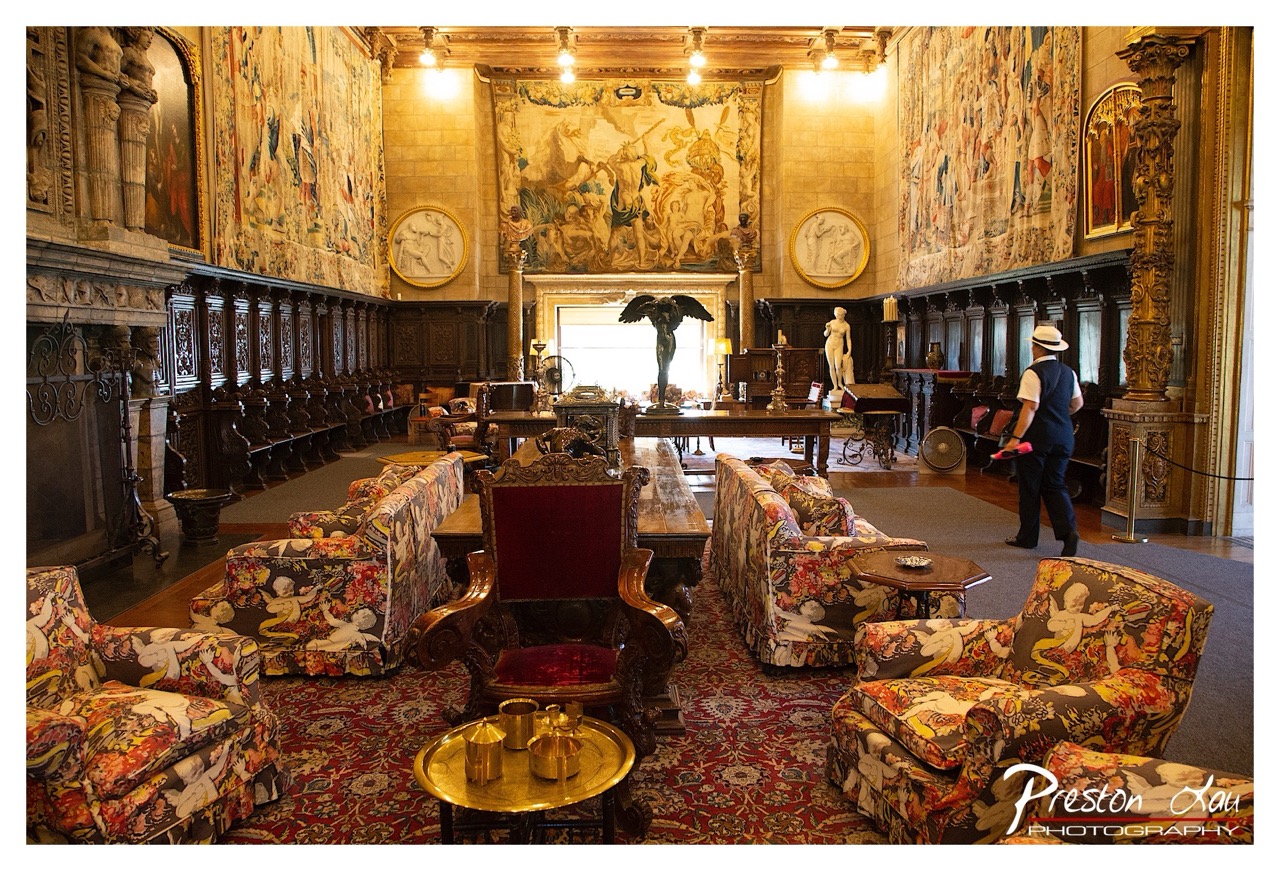

1. Overall Rating (0–10) — 8.0
This photograph captures the opulent grandeur of a historic hall, where centuries of artistry and craftsmanship converge in a richly layered visual narrative. The interplay of intricate tapestries, gilded statuary, and ornate woodwork creates a sense of timelessness, while the presence of a visitor grounds the scene in contemporary life. Though the composition is dense and occasionally busy, the image successfully conveys the room’s majesty and narrative depth, inviting the viewer to explore its historical weight.
2. Composition (0–10) — 7.5
The wide-angle perspective captures the full scale of the hall, with the central tapestry and fireplace serving as strong focal points. The arrangement of furniture creates diagonal lines that guide the eye toward the back of the room, though the foreground elements slightly clutter the visual flow.
3. Lighting (0–10) — 7.0
Warm, ambient lighting from overhead fixtures enhances the richness of the materials, casting soft glows on the tapestries and wood. The natural light from the back window adds balance, though some areas remain slightly underexposed.
4. Color & Tone (0–10) — 8.0
The warm, earthy palette—rich reds, golds, and deep browns—complements the historical atmosphere, while the floral upholstery introduces subtle pops of color that add visual interest without disrupting harmony.
5. Creativity (0–10) — 8.0
The photograph blends documentary realism with artistic framing, using the visitor’s presence to add narrative context. The interplay between old and new, sacred and secular, gives the image a layered, almost cinematic quality.
6. Technical Quality (0–10) — 8.5
Sharp focus across the frame, excellent detail in textures, and clean exposure control reflect high technical proficiency. The depth of field effectively captures both foreground and background elements.
7. Emotional Impact (0–10) — 8.5
The image evokes awe and reverence, inviting contemplation of the past. The quiet presence of the visitor enhances the sense of shared history, making the viewer feel both an observer and a participant in the moment.
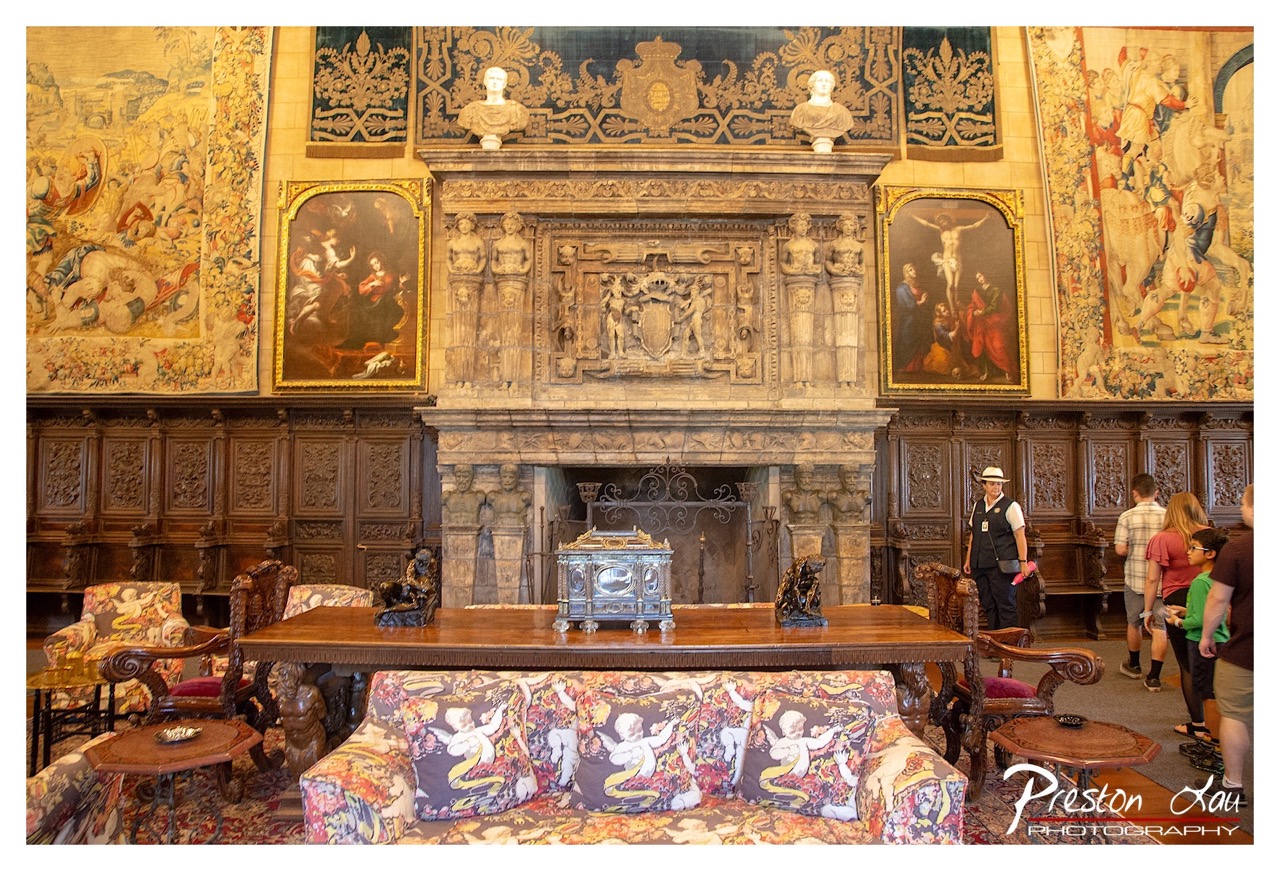

1. Overall Rating (0–10) — 7.5
This photograph captures the opulent grandeur of a historic hall, where intricate woodwork, tapestries, and classical art converge to evoke a sense of timeless elegance. The composition draws the eye to the central fireplace, a monumental focal point, while the presence of visitors grounds the scene in reality. Though the image is rich in detail, its visual complexity risks overwhelming the viewer, and the slightly cluttered arrangement of furniture and objects tempers its overall harmony.
2. Composition (0–10) — 7.0
The central fireplace anchors the frame with strong symmetry, while the surrounding tapestries and paintings create a layered, balanced environment. The inclusion of visitors on the right adds narrative context but slightly disrupts the formal composition.
3. Lighting (0–10) — 6.5
The ambient light is even and bright, illuminating the room’s intricate details without harsh shadows. However, the artificial lighting lacks depth, flattening the textures of the wood and fabric.
4. Color & Tone (0–10) — 7.5
The warm, earthy palette—rich browns, golds, and deep reds—enhances the room’s historic and luxurious feel. The tapestries and upholstery contribute vibrant color contrasts, though some areas appear slightly overexposed.
5. Creativity (0–10) — 7.0
The photograph successfully captures the interplay between art, architecture, and human presence, offering a narrative glimpse into a preserved historical space. The framing suggests a story of continuity between past and present.
6. Technical Quality (0–10) — 8.0
The image is sharp and well-focused, with clear details visible in the carvings, textiles, and artworks. The exposure is balanced, and the watermark is discreet, preserving the image’s integrity.
7. Emotional Impact (0–10) — 7.0
The room evokes awe and reverence, drawing the viewer into a world of craftsmanship and cultural legacy. The presence of people adds a touch of relatability, bridging the gap between history and the present moment.
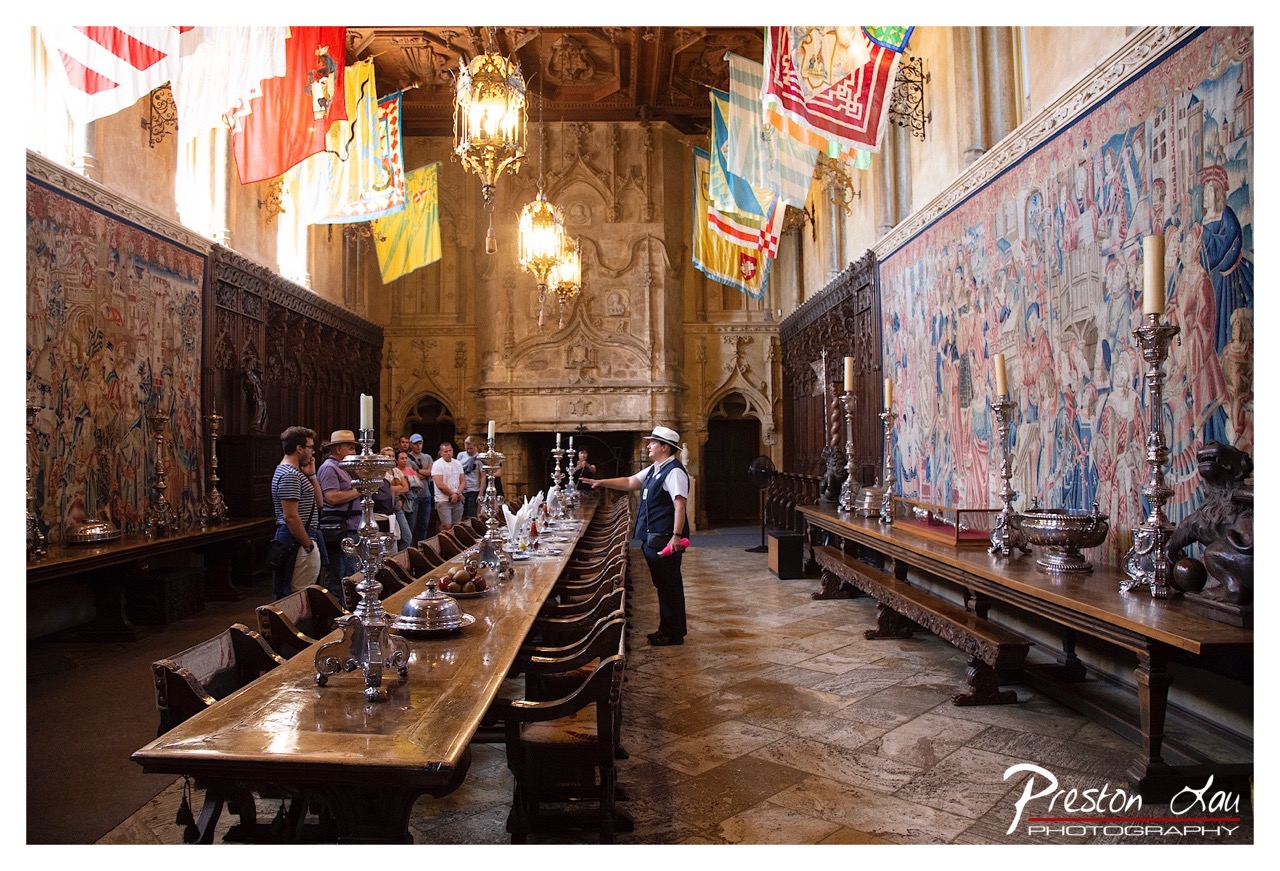

1. Overall Rating (0–10) — 7.5
This photograph captures the grandeur and historical weight of a medieval hall, where opulent tapestries, ornate woodwork, and ceremonial banners evoke a sense of timelessness. The guide’s presence adds a narrative layer, grounding the scene in the present while inviting viewers into a story of heritage and tradition. While the composition is rich in detail, the abundance of visual elements risks overwhelming the eye, slightly diminishing the image’s overall cohesion.
2. Composition (0–10) — 7.0
The long dining table creates a strong leading line, drawing the viewer’s gaze toward the central fireplace and the guide. The symmetry of the hall is well-balanced, though the inclusion of the group of tourists on the left introduces a subtle disruption to the formal arrangement.
3. Lighting (0–10) — 7.5
Warm, ambient light from the chandeliers enhances the richness of the wood and tapestries, while natural light from the windows adds depth and dimension. The interplay of light and shadow accentuates the architectural details without creating harsh contrasts.
4. Color & Tone (0–10) — 8.0
The palette is rich and harmonious, with deep reds, golds, and earthy tones in the tapestries and woodwork creating a cohesive and regal atmosphere. The warm tonal balance complements the historical setting, adding to the image’s immersive quality.
5. Creativity (0–10) — 7.0
The image successfully blends documentary and artistic elements, capturing both the architectural splendor and the human presence within the space. The inclusion of the guide introduces a narrative of interpretation, elevating the photograph beyond mere documentation.
6. Technical Quality (0–10) — 8.0
The image is sharp and well-focused, with excellent detail in the textures of the wood, tapestries, and metalwork. The exposure is balanced, and the resolution captures the intricacies of the hall without overprocessing.
7. Emotional Impact (0–10) — 8.0
The photograph evokes a sense of awe and reverence, inviting the viewer to imagine the ceremonies and lives that once filled this space. The presence of the guide and tourists adds a touch of connection, making the historical grandeur feel accessible and alive.
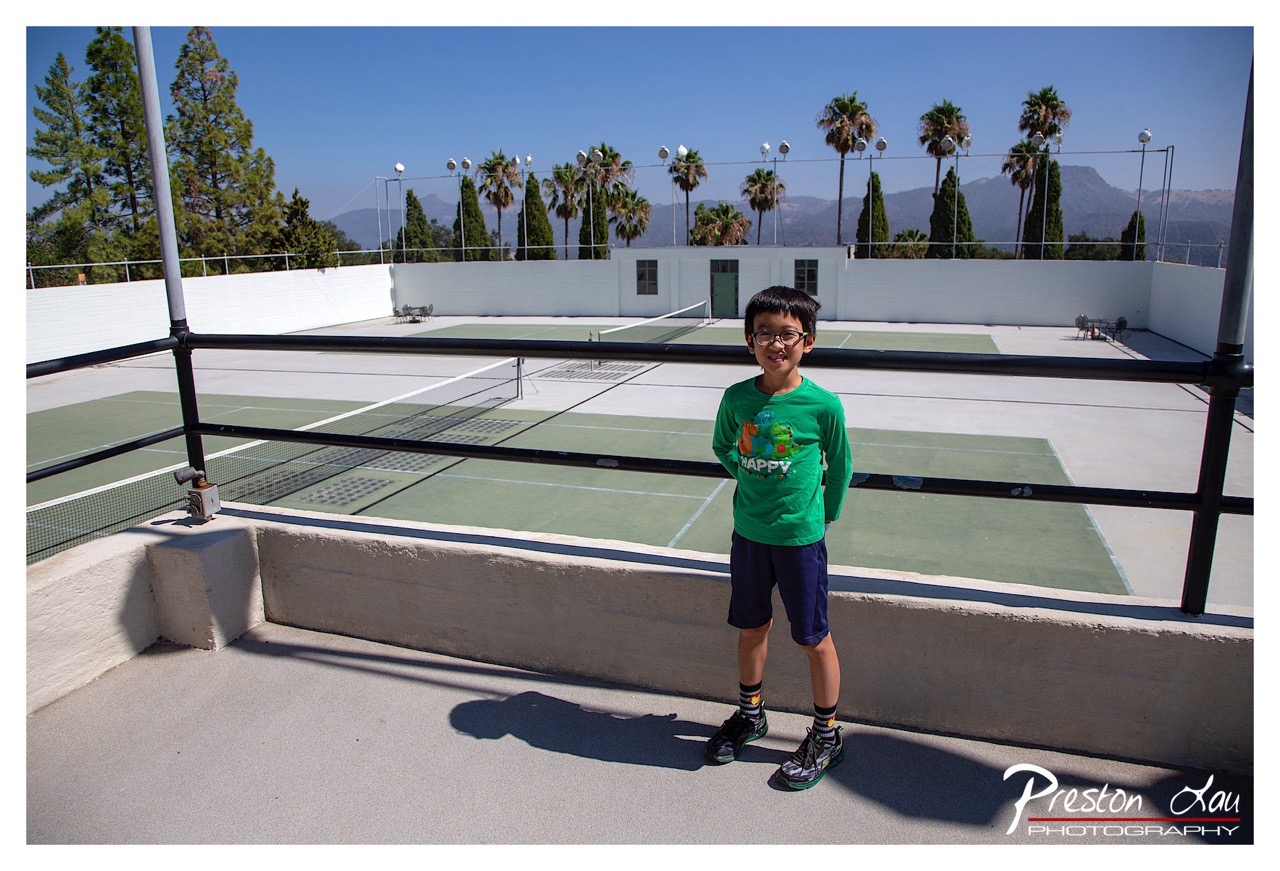

1. Overall Rating (0–10) — 7.5
This photograph captures a bright, sun-drenched moment of youthful confidence on a tennis court, where the subject’s cheerful presence contrasts beautifully with the expansive, serene landscape behind him. The wide-angle perspective emphasizes the scale of the environment while grounding the image in a personal, relatable moment. While the composition is strong and the lighting is natural and vibrant, the slightly awkward framing and overexposed highlights slightly diminish the image’s overall polish.
2. Composition (0–10) — 7.0
The boy is positioned off-center, creating a dynamic balance with the vastness of the tennis courts and distant mountains. The railing in the foreground adds depth, though its horizontal lines compete with the subject’s placement, slightly disrupting visual flow.
3. Lighting (0–10) — 8.5
Strong, direct sunlight enhances the clarity and saturation of the scene, casting a crisp shadow that anchors the boy in space. The high contrast between light and shadow adds dimension, though some highlights in the sky and pavement are slightly blown out.
4. Color & Tone (0–10) — 8.0
The vivid green of the boy’s shirt and the courts contrasts sharply with the blue sky and earthy tones of the background, creating a lively, energetic palette. The overall tone is warm and sunlit, reinforcing the outdoor, daytime atmosphere.
5. Creativity (0–10) — 7.5
The image successfully blends a candid moment with a scenic backdrop, transforming a simple portrait into a narrative about youth, activity, and place. The choice to include the expansive environment elevates the personal subject into a broader context.
6. Technical Quality (0–10) — 8.0
Sharp focus on the boy, clean detail throughout, and accurate exposure—despite minor overexposure in bright areas—demonstrate strong technical control. The wide lens is used effectively to capture both subject and setting.
7. Emotional Impact (0–10) — 8.0
The boy’s warm smile and relaxed posture convey genuine happiness and pride, inviting the viewer into a moment of quiet joy. The combination of personal expression and scenic beauty creates a strong sense of connection and optimism.
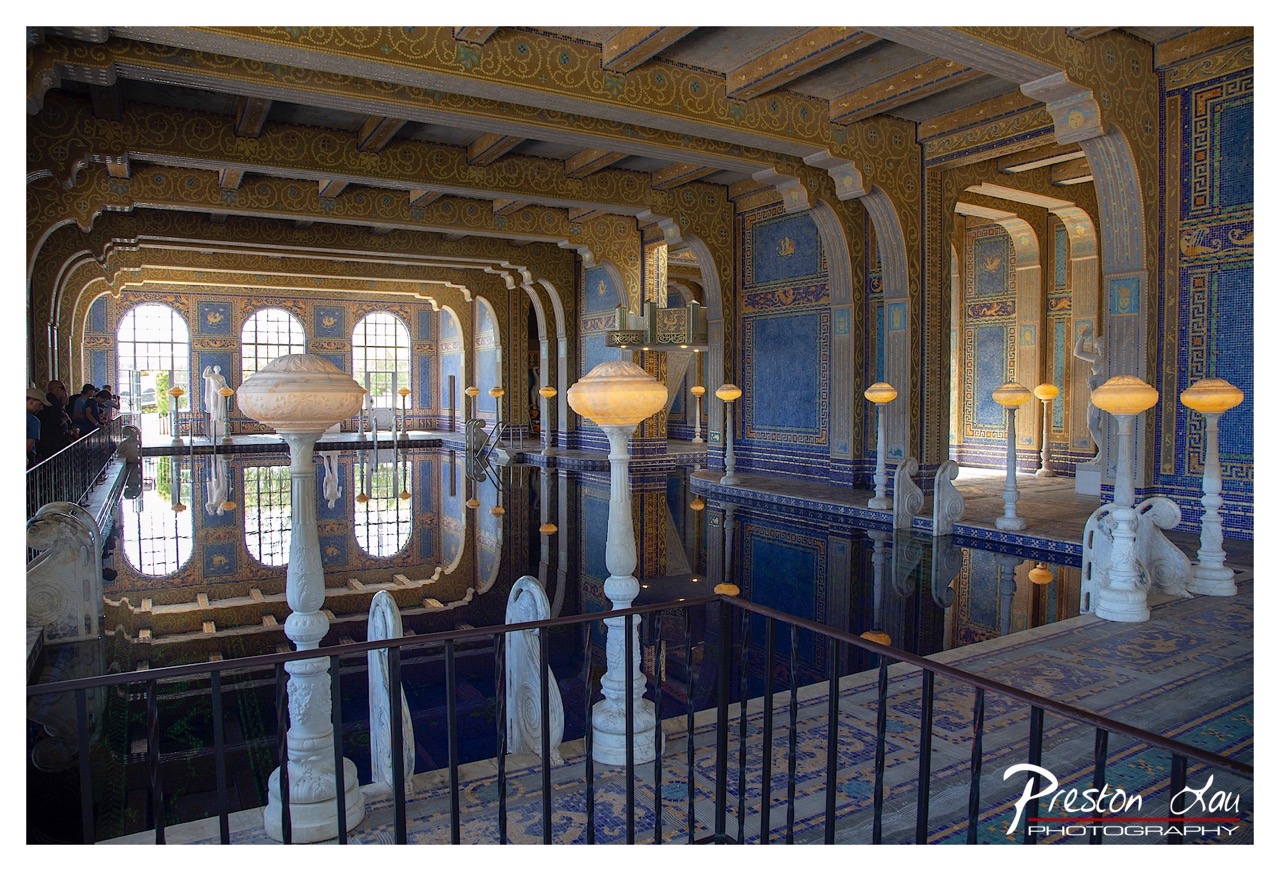

1. Overall Rating (0–10) — 8.0
This photograph captures the opulent grandeur of an ornate indoor pool, where architectural symmetry and rich detailing evoke a sense of timeless luxury. The interplay of light, reflection, and intricate mosaic work creates a visually immersive experience, drawing the viewer into a world of classical elegance. While the scene is rich in detail, the inclusion of visitors slightly disrupts the idealized stillness, grounding the image in reality but softening its cinematic allure.
2. Composition (0–10) — 8.5
The symmetrical framing guides the eye through the arched recesses and columns, emphasizing the architectural rhythm. The use of leading lines from the railings and the pool’s edge enhances depth, while the balanced placement of the lamps and statues creates visual harmony.
3. Lighting (0–10) — 7.5
Natural light streams through the arched windows, casting soft, diffused illumination that enhances the textures of the mosaic tiles and marble. The warm glow of the lamps adds a subtle contrast, enriching the scene with depth and atmosphere.
4. Color & Tone (0–10) — 8.5
The dominant blue and gold palette exudes regality, with the cool tones of the tiles complementing the warmth of the ornate ceiling. The reflections on the water amplify the richness of the colors, while the tonal balance ensures a cohesive and immersive visual experience.
5. Creativity (0–10) — 8.0
The photographer captures both the architectural splendor and the quiet human presence within the space, transforming a historical interior into a narrative of leisure and beauty. The choice to include people subtly suggests life within the monument, adding a layer of storytelling.
6. Technical Quality (0–10) — 8.5
Sharp focus across the scene, with excellent clarity in both the foreground and background details. The exposure is well-managed, preserving the nuances of light and shadow without overexposure or loss of detail.
7. Emotional Impact (0–10) — 7.5
The image evokes a sense of awe and tranquility, inviting the viewer to imagine the history and elegance of the space. The combination of scale, design, and human presence creates a contemplative mood, blending admiration with quiet introspection.
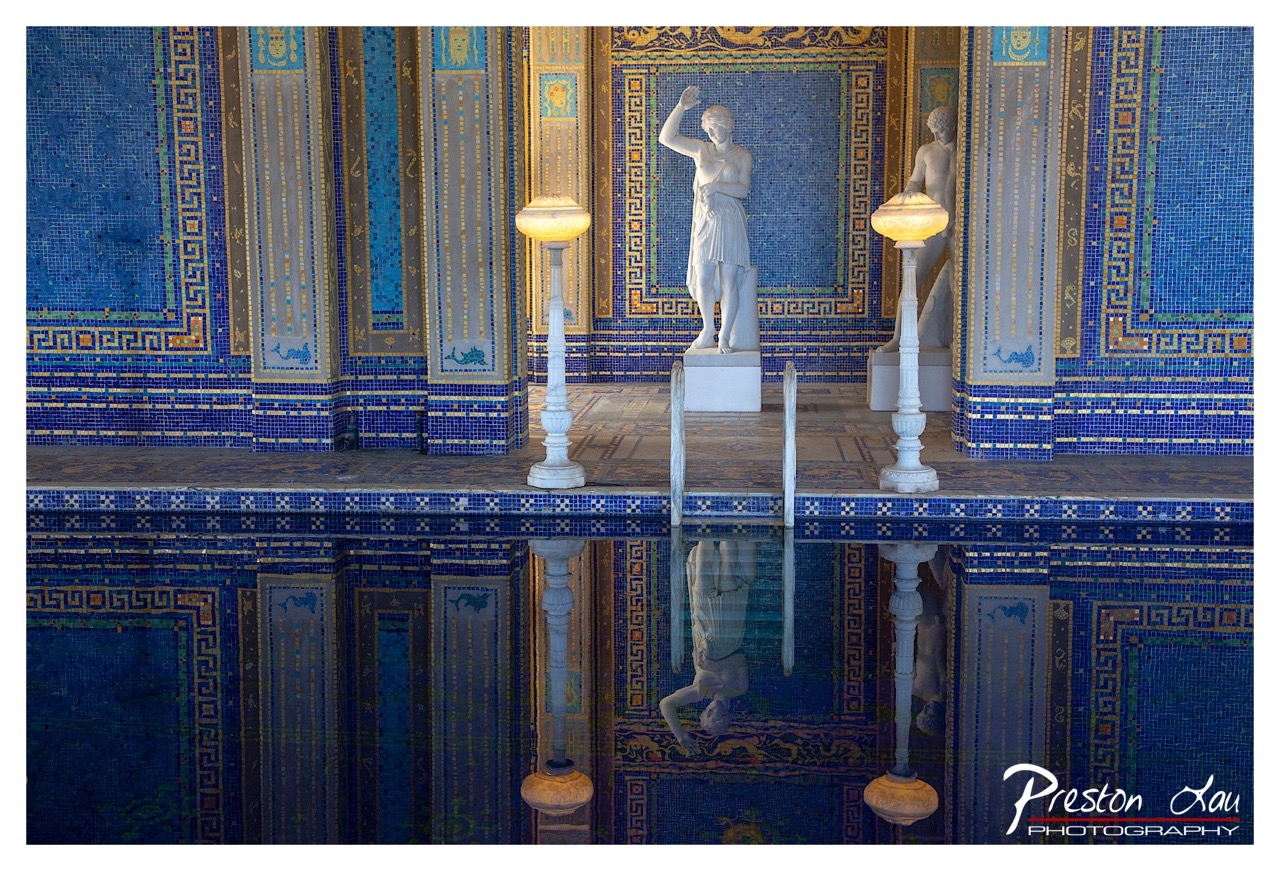

1. Overall Rating (0–10) — 8.0
This photograph captures a striking symmetrical composition within a richly decorated interior, where the stillness of the water mirrors the classical elegance of the statues and mosaic walls. The deep blue tiles and ornate patterns evoke a sense of ancient luxury, while the perfect reflections lend a dreamlike quality to the scene. The image’s strength lies in its balance and harmony, though the lack of human presence tempers its emotional immediacy.
2. Composition (0–10) — 9.0
The image is masterfully balanced, with the central statue and flanking lamps creating a strong focal point. The symmetry is reinforced by the flawless reflection in the water, drawing the eye toward the center and enhancing the sense of order and grandeur.
3. Lighting (0–10) — 7.0
The warm glow of the lamps contrasts beautifully with the cool blue of the mosaic, adding depth and dimension to the scene. The lighting is soft and even, enhancing the textures of the tiles and the smoothness of the marble without creating harsh shadows.
4. Color & Tone (0–10) — 8.5
The dominant blue palette is rich and immersive, complemented by the golden accents in the mosaic and the warm light of the lamps. The contrast between cool and warm tones creates a visually dynamic and harmonious atmosphere, enhancing the image’s regal feel.
5. Creativity (0–10) — 8.0
The photographer leverages symmetry and reflection to transform a static architectural space into a visually compelling narrative. The choice to emphasize the mirror-like surface of the water adds a layer of surreal beauty, turning a historical setting into a timeless, almost otherworldly scene.
6. Technical Quality (0–10) — 8.5
The image is sharp and well-focused, with excellent detail in both the mosaic textures and the reflective surface of the water. The exposure is balanced, and the depth of field ensures that both the foreground and background elements are clearly rendered.
7. Emotional Impact (0–10) — 7.5
The photograph evokes a sense of tranquility and reverence, inviting the viewer to pause and contemplate the beauty of classical design. The stillness and symmetry create a meditative mood, though the absence of human activity keeps the emotional connection subtle and contemplative.
Loading map...